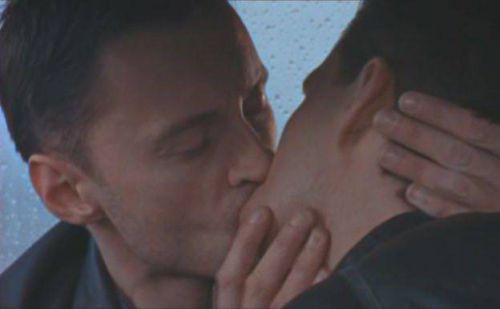From the Chicago Reader (April 14, 1995). I’m not sure why, but this is one of the most popular posts on this site. — J.R.

Priest
**
Directed by Antonia Bird
Written by Jimmy McGovern
With Linus Roache, Tom Wilkinson, Cathy Tyson, Robert Carlyle, James Ellis, Lesley Sharp, Robert Pugh, and Christine Tremarco.

A friend of mine who hasn’t even seen Priest calls it “post-Oprah,” and it’s easy to see what he means — in terms of pacing as well as subject matter. Its first incarnation was as a 200-page script by Jimmy McGovern for a four-part BBC miniseries, but he shaved it to 65 pages when the BBC decided to make it a feature. When it went out to festivals last year (where it won numerous awards), director Antonia Bird’s cut was 109 minutes; since then it’s been trimmed by 8 minutes, apparently to make it eligible for an R rating: its distributor, Miramax, now under the control of the Disney studio, isn’t allowed to release any NC-17 pictures. I haven’t seen the longer version, but it’s likely that these successive abridgments have both produced the taut narrative that’s central to the movie’s powerful impact as entertainment and limited it as art and as a piece of sustained thought. Read more
From Film Quarterly (Spring 1974). I wrote this review while I was living in Paris, which made acquiring a review copy especially difficult. (I grimly recall even getting into something resembling a fistfight with the French distributor of the book, who didn’t want to give me one and blew a fuse when I insisted, even though I had an assignment.) Stephen Koch, whom I knew from my previous stint as a graduate student at the State University of New York at Stony Brook, was a friend at the time, as was Annette Michelson, who commissioned the book for Praeger. My second-hand assessment of **** (Four Stars) came from another friend, Lorenzo Mans, who saw the entire film and reviewed it for the Village Voice, though I had attended a New York screening of Blue Movie, when it went by the title Fuck. -– J.R.

STAR-GAZER:
ANDY WARHOL’S WORLD AND HIS FILMS
BY Stephen Koch. New York: Praeger. $8.95.
Books about filmmakers that do something more than regurgitate filmographies and sketch career summaries are not exactly plentiful these days, and for this reason alone Stargazer is worthy of serious attention. What it attempts is not a mere pigeon-holing of Warhol’s films but a complex assessment of his persona and its accompanying strategies — in, through and beyond these films — as they flourished in the sixties. Read more


